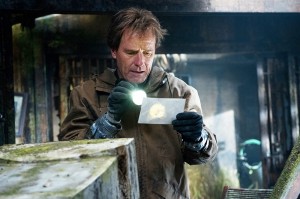
The kaiju are back, and this time there aren’t any giant human-piloted robots to protect us! Humanity’s only defense against malevolent skyscraper-sized monsters in Gareth Edwards’ “Godzilla” is the spiked, city-destroying, atomic-breathing King of Monsters himself. Released May 16, the movie is an epic reboot of the franchise and legacy started 60 years ago by the Toho Motion Picture Co. with Ishiro Honda’s 1954 B-movie classic, bringing dignity and a badass redesign to the beast who has become somewhat of a joke over the years.
While this is only the director’s second feature and his first big popcorn flick, he works with the skill and eye for detail of a younger Steven Spielberg, evoking genuine wonder and thrills with a creature feature that will both make you feel like a kid again and completely wipe the 1998 Matthew Broderick version from your mind.
It seems like Edwards’ first movie, “Monsters” (2010), a story about aliens being quarantined on the U.S.-Mexico border by the government, was good practice before he tackled the most iconic monster of them all, who has heavily inspired popular culture (from Reptar to Power Rangers villains) since he first stepped out of the sea. Unlike his Cold War counterpart, this Godzilla is not a product of nuclear radiation (somewhat of a disappointment for me) but is instead an ancient creature, a force of nature that was awoken in the 1950s and targeted in government-sanctioned atomic bombings in the Pacific (e.g., Bikini Atoll) that had been covered up as “tests.” This is all shown in a cool redacted opening credit sequence full of grainy footage.
The movie follows multiple sets of characters as they come into contact with Godzilla and his nemeses, the terrifying MUTO (Massive Unidentified Terrestrial Organisms), Mothra-like parasites who feed off of radiation, emit electromagnetic pulses and get more screen time than the title character. Of all the storylines, the most captivating is that of Ford Brody (Aaron Taylor-Johnson) and his father, Joe (Bryan Cranston). As stated by others, it’s these characters who keep the movie relatable amid giant monsters beating the snot out of each other.
Their story begins when a nuclear power plant in Japan collapses due to a supposed earthquake, killing Ford’s mother (Juliette Binoche). As a result his father goes somewhat insane, concocting crackpot theories that turn out to be correct and dragging his son into the thick of the action. While he doesn’t spend too much time on the screen, Cranston is amazing as usual, stealing every scene he’s in as an obsessed man who will stop at nothing to discover the truth. Like any good B-monster movie, the military eventually gets involved and is woefully ill-equipped to handle the situation, relying on the giant lizard to restore balance to nature.
Thanks to the plot points of cover-ups, secret facilities and foreign scientists, the movie emits a “Close Encounters” vibe that harkens back to the early days of summer blockbusters in the ‘70s. Taylor-Johnson steps into the Richard Dreyfuss/Roy Neary role as a simple family man who gets caught up in something much bigger than himself. Reminiscent of Francois Truffaut’s Claude Lacombe is Ken Watanabe as Dr. Ishiro Serizawa; a nod to Godzilla’s Japanese origins and the physical embodiment of the nuclear bombings on Japan during World War II.
His character also switches the warning of the original film from the fear of atomic might to man’s ignorant belief that he can control nature. Furthering the Spielberg comparisons, Edwards has some shots that say more than dialogue ever could, be it a cockroach crawling over a toy tank or a coffee table littered with a young boy’s plastic dinosaurs. There’s even a small wink to one of Toho’s other “Big Five” monsters, Rodan, in a children’s schoolroom.
At times, the plot does stall during the human-centric moments (when they could show more Godzilla/MUTO brawls, which are the coolest and most destructive scenes in the movie), and Max Borenstein’s script has a few preposterous moments and plot conveniences. That being said, when has a monster movie ever not been preposterous, especially the ones made in the ‘50s with their laughable special effects and men in costume destroying model cities? Here, the effects are amazing, lending themselves to some great sequences like a speeding train on fire, fighter planes falling like flies into the San Francisco Bay, the destruction of Las Vegas after a visit to a Nevada nuclear storage facility, a melee at a Hawaiian airport just after a tsunami that signals the king’s arrival, and an exciting final battle in the streets of San Francisco that had the audience cheering in their seats. It seems that after taking many hits over the years, Tokyo was finally spared this time around. Setting the mood for every scene, Alexandre Desplat’s sweeping, horn-filled score has a presence as massive as the creatures themselves, redolent of the cues used by Akira Ifukube on the 1954 soundtrack.
With the release of Guillermo Del Toro’s “Pacific Rim” last year, it would seem that Hollywood has successfully resurrected the kaiju/nuclear monster genre, finding a nice balance between campy and serious elements in the plot lines. A new strain of respectable, well-produced B-movies has been created. Perhaps they can also bring back the best elements of the era in which they were born, like drive-in theaters where audiences once screamed in terror at the giant, irradiated ants in “Them!” and listened thoughtfully to the wise message of our own destructive habits by the alien Klaatu in “The Day The Earth Stood Still.” With Edwards’ contribution, I’d say we’ve taken a Godzilla-sized step in the right direction.

